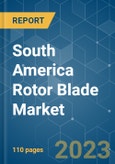The South American rotor blade market is expected to register at a CAGR of about 5.1% during the forecast period.
The market was moderately impacted by COVID-19 in 2020. It has now reached pre-pandemic levels.
This product will be delivered within 2 business days.
The market was moderately impacted by COVID-19 in 2020. It has now reached pre-pandemic levels.
Key Highlights
- Over the long term, the major driving factors of the market are expected to be the growing number of offshore and onshore wind energy installations across the region.
- On the flip side, the associated high cost of transportation and cost competitiveness of alternate clean power sources, like solar power, hydropower, etc., have the potential to hinder market growth.
- The wind power industry has been in demand for cost-effective solutions, and a highly efficient product can change the industry's dynamics. There were instances where old turbines were replaced, not because of the damage but due to the availability of more efficient blades in the market. Hence, technological developments are opportunities for the South American rotor blade market.
- Brazil is expected to dominate the rotor blade market, with growing wind power installations across the country.
South America Rotor Blade Market Trends
Onshore Segment to Dominate the Market
- Onshore wind energy power generation technology has evolved over the last five years to maximize electricity produced per megawatt capacity installed and to cover more sites with lower wind speeds. Besides this, in recent years, wind turbines have become larger with taller hub heights, broader diameters, and larger wind turbine blades.
- As of November 2021, the installed wind power capacity surpassed 20 GW. The nation has over 10,000 wind turbines installed across 750 operational wind parks. The Brazilian Electricity Regulatory Agency (ANEEL) has approved more than 350 new wind power projects with a total capacity of over 12 GW, out of which 170 projects are under construction.
- According to the Global Wind Energy Report 2022, Brazil is in sixth place in the global ranking, with 21.5 GW of onshore wind installed capacity. Furthermore, according to the Brazilian Association of Wind Energy (ABEEólica), Brazil will have at least 30 GW of installed wind energy capacity by 2024. This, in turn, aids the growth of using rotor blades for wind plants across the region.
- Chile has more than a gigawatt of installed onshore wind capacity, which is the second-highest in South America. Chile has ambitious plans for renewable energy, which, in turn, is expected to drive the onshore market in the region.
- Furthermore, decreasing the cost of power generation and growing investments, particularly in Brazil, Chile, and Argentina, are expected to drive the onshore wind turbine installation, which, in turn, is expected to drive the wind rotor blade market in the region during the forecast period.
- Owing to these factors, the onshore segment is expected to dominate the market during the forecast period.
Brazil is Expected to Dominate the Market
- Wind energy is Brazil's second-largest source of power generation, and its importance grows yearly. Wind energy production in the country hit a record in 2021, exceeding 20 GW of installed capacity, and wind power generation was about 72.286 Gwh.
- In addition, the growing size of wind turbines has assisted in lowering the cost of wind energy, indicating that it is economically competitive with fossil fuel alternatives. As of June 2022, 65 onshore wind projects are planned over the next five years, with a total investment of USD 23 billion. The Bahia (USD 7 billion), Rio Grande do Norte (USD 6 billion), the Rio Grande do Sul (USD 3 billion), and Piauí (USD 2 billion) are the states investing the most in onshore wind energy projects.
- In April 2022, Danish wind giant Vestas finalized a multi-year supply agreement with blade maker LM Wind Power, focused on the onshore Brazilian market with the flexibility for export. Under the deal, LM Wind Power will deliver Vestas's V150-4.2MW turbine blades from its factory in Ipojuca in Pernambuco.
- In December 2021, Chinese manufacturer Sinoma Science and Technology announced its plan to expand business in Brazil by building a USD 28.8 million plant to manufacture wind turbine blades. Sinoma will set up a joint venture with Sinoma Overseas Development, a contractor under Sinoma Science's parent company China National Building Material Group (CNBMG), to build the plant in Salvador. The new plant will produce 260 power blade sets a year.
- Owing to the above points, Brazil is expected to dominate the market during the forecast period.
South America Rotor Blade Market Competitor Analysis
The South American rotor blade market is fragmented in nature. Some of the major players in the market (in no particular order) include TPI Composites SA, LM Wind Power (a GE Renewable Energy business), Siemens Gamesa Renewable Energy SA, Vestas Wind Systems A/S, and Enercon GmbH.Additional benefits of purchasing the report:
- The market estimate (ME) sheet in Excel format
- 3 months of analyst support
This product will be delivered within 2 business days.
Table of Contents
1 INTRODUCTION
4 MARKET OVERVIEW
5 MARKET SEGMENTATION
6 COMPETITIVE LANDSCAPE
Companies Mentioned (Partial List)
A selection of companies mentioned in this report includes, but is not limited to:
- TPI Composites Inc.
- Lianyungang Zhongfu Lianzhong Composites Group Co. Ltd
- LM Wind Power (a GE Renewable Energy business)
- Nordex SE
- Siemens Gamesa Renewable Energy SA
- Vestas Wind Systems A/S
- MFG Wind
- Sinoma wind power blade Co. Ltd
- Aeris Energy
- Suzlon Energy Limited
- Enercon GmbH
Methodology

LOADING...










